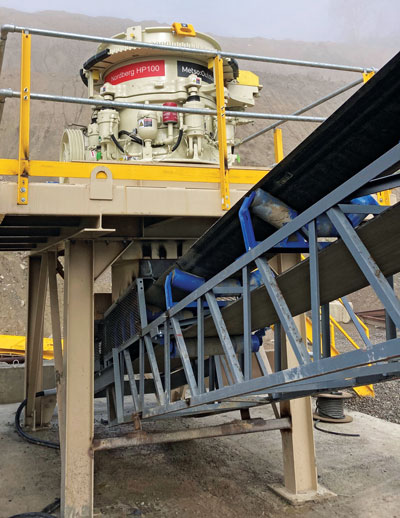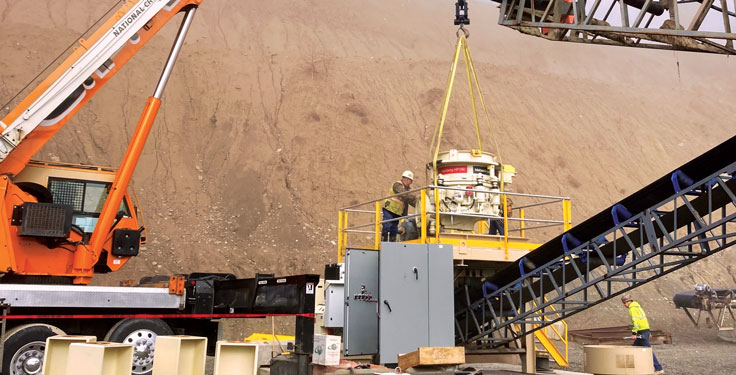
• Guards. Guards should be substantial and robust – enough to prevent any accidental contact.
Unfortunately, many of you have seen guards held in place by zip ties. Plus, how many times have you seen a guard at the head pulley so full of material that it pushes the expanded metal out?
I have also observed guards with grease hoses tied to them – and gobs of grease piled up on the catwalk below where a groundman wasn’t paying attention. These messes are sometimes not addressed quickly and can lead to bigger issues.
Take your time while walking conveyors to address these sorts of issues before they become problems. Also, take time during your conveyor walks to look at your return roller guards. You can easily miss the amount of material being held up on that thin expanded metal – and it’s even worse to remove this without help.
• Catwalks. Walking your plant is the perfect time to look closely at catwalks.
When I worked as a young ground man, I was tasked daily with walking the conveyors at my plant. One critical piece of equipment I carried while doing my walks was a wooden-handled chipping hammer. I carried this with me to every conveyor, and it served me well in what may be the most boring task a young man can ever take on: removing rocks from catwalk tread plates.
The plant I started out at had expanded metal with kickboards, which made this a very time-consuming task. So, I used the chipping hammer to dislodge every rock that would not pass through that expanded metal. While doing this job, I learned a valuable lesson that I still use every day.
One day while my plant was down, a longtime truck driver came down from the dump bridge and started to clean a catwalk that was running close to the one I was on.
Every so often, he would throw a couple of rocks over and then stop and look around – at the structure, at the belt, at the rollers, at any working part that was close to him.
I was curious, and after watching him for a while I had to ask what he was doing. He called for me to come over to see, and I walked up the conveyor to meet him. Once on the conveyor, he pointed out a few bad rollers and some other small issues he’d spotted.
He explained that just because I was doing one task didn’t mean I couldn’t observe and check for other possible trouble areas. He taught me value in multitasking and taking the time to look for the “small things.”
Other considerations
• Grease those pulleys. Grease worms are a mean beast to combat, but the best-kept secret to control them is to have a routine. Make it your standard course of action to grease your plant’s equipment the same way and at the same time – as often as you determine is needed.
Personally, I greased my areas three times a week. I’ve worked at plants that greased daily, and I’ve observed those that grease once a week. I have also been to plants where a grease gun was rarely in use.
Grease is the life of any bearing, and bearings are the life of pulleys. It’s a simple addition to your routine that can make a huge difference.
• Drive belt inspections. Make sure to routinely check drive belts, too. Simply walking by and verifying that they are all on the sheave does not constitute an inspection.
To conduct a true inspection, lock out, tag out and try out. The guard should be removed to conduct a proper inspection of your drive belt. There are several things you should inspect while the guard is off.
• Belt placement. See that all belts are accounted for and where they should be.
• Sheave condition. Check to make sure belts are not “bottoming out” in the sheave and that the top of the sheave isn’t razor sharp between the belts.
• Belt condition. Dry rot, shredding and excessive rubber dust can all be signs of impending failure.
• Proper belt tension. Belts that are too tight can cause as much of an issue as loose belts. You won’t have to worry about slipping with a tight belt, but being too tight can cause issues such as premature belt and bearing failure.
Get to know secondary equipment
It is vital to get to know your secondary equipment and that you routinely assess it to ensure everything stays in optimal working order.
The more familiar you are with equipment, the easier it is to spot a potential issue and address it before it becomes a problem. Some things, including conveyor belts, should even be inspected daily.
Belts should be walked daily, and any abnormality or issue should be addressed – or at least noted immediately – so plans can be made to fix them to prevent a disruption in production.
Routine is your friend. By creating a routine, you can easily spot when things aren’t right.
Brandon Godman is sales engineer at Marion Machine.












